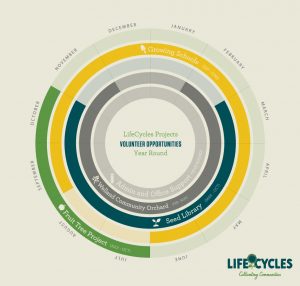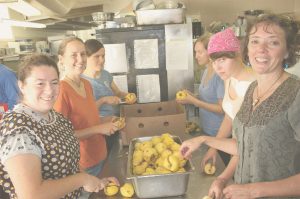Eliademy for a small non-profit food education program
Introducing an LMS into the Growing Schools program
About Growing Schools
Growing Schools is a program run by the not-for-profit organization LifeCycles, based in Victoria, British Columbia. Growing Schools aims to connect local elementary school children to gardens, local ecosystems, and the food they eat. The vision of the program is “a garden in every school where children, teachers, parents, and community members gather to learn and grow together.” Students in schools that partner with Growing Schools attend five hands-on classes taught by volunteers from September through June. The volunteers receive training in organic gardening, environmental issues, local food systems, biodiversity and other subjects in order to teach these workshops.The curriculum model promotes learning outcomes created by the Ministry of Education and touches upon a range of subjects like Science, Social Studies and Math.
Aside from one paid coordinator, Growing Schools relies on and is operated by volunteers. The growth and sustainability of this program is dependent on attracting, training, and retaining volunteer educators. It is very important that Growing Schools finds a way to provide the educational content required to the volunteers in an easy and affordable way, both in terms of deliverability and accessibility. Currently, volunteer training is limited to three in-person training nights in the spring. If volunteers aren’t able to make those dates, they cannot be involved with workshop delivery that gardening season. This limits the number of volunteers that can be brought on and trained each season, which in turn limits the number of workshops that can be delivered in schools.
Why implement a Learning Management System?
Creating an online community of practice and learning management system for Growing Schools would expand the program’s capacity to deliver workshops and to bring more schools into the program. Eliademy, a cloud-based online Learning Management System (LMS), provides an easy to use shell that can be set up to deliver Growing Schools’s training courses to volunteers. Moving to an online platform for delivery, will empower Growing Schools to reach and extend both their volunteer base and to collaborate with a greater number of schools.
Affordances and features of Eliademy
Affordability
Perhaps the most important factor for a small non-profit organization is the affordability of the software. Eliademy offers a free version of its LMS that provides the required functionality for this organization. It is free for learners to register for an account, and once they do, they have access to other free courses in a variety of subjects.
Accessibility
The functionality within Eliademy is a great fit with Growing Schools’s goals and vision. All of the courses offered by the organization are run by volunteers so it is essential that these volunteers receive adequate training. As Eliademy is accessible wherever you have Internet access, this would greatly increase the organization’s outreach as volunteers virtually anywhere could receive the training they need. Once created, courses can easily be shared with volunteers by simply sending an invitation via email or posting a link on Facebook or Twitter. All of the courses created would be open to the public and free to attend. Furthermore, keywords can be set for the course so that it is easily discoverable thus increasing the organization’s outreach and allowing their message to reach even more people.
Ease of use
One of the most important factors when selecting a Learning Management System is usability. Usability is defined as “the extent to which a product can be used by specified users to achieve specified goals with effectiveness, efficiency and satisfaction,” (Ivanc, Vasiu & Onita, 2012, p.349). Usability within the selected LMS is especially important for Growing Schools, as it is possible that the individuals building these courses will not have a background in educational technology. It is also possible that this could be the volunteers’ first exposure to online learning so the tool must be intuitive and easy to use for both the course builder and the volunteers taking the courses. Ivanc, Vasiu and Onita (2012) proposed several factors to evaluate the usability of a system, including the ease of navigation, the help topics available to the user, and the general attractiveness of the LMS.

Eliademy makes it very easy for anyone to create online courses. It is simple to register for an account and courses can be simply and quickly created using the visual editor. There is a short introductory video that covers course creation and teaches a user how to build a course in under five minutes. Users can create a new course from scratch or can copy and paste existing content. The course builder is fully compatible with Microsoft Office applications so any existing content can be copied over without losing the formatting. It is also possible to attach an unlimited number of supporting documents to each course topic. Images and videos can be added and the course creator can easily change the fonts and colours within the lessons, resulting in an attractive end product for the learner. The ease of navigation will allow Growing Schools to create the courses in-house rather than hiring a contractor.
Additionally, as a cloud-based virtual learning management system, Eliademy saves the organization from having to purchase online storage space for their course. Valuable learner analytics such as enrollment history, engagement with course content, task submission progress and grade distribution are also free, allowing Growing Schools to assess the effectiveness of the online courses.
Online learning environment
In addition to taking into consideration the usability of the LMS, it is also important to consider whether the site has the capabilities to create a rich learning environment. In Fink’s (2003) paper on designing courses for significant learning, she discusses the importance of designing feedback and assessment opportunities, as well as including active learning in courses. Eliademy includes many functionalities that allow for the design of a rich learning environment. Courses can be made interactive through the use of tasks, quizzes, and communications to ensure that volunteers are continually engaged throughout the course. For further interactivities, over 160 external sources can be incorporated into the course such as streaming video and audio, Prezi and Slideshare presentations, and syncing up with Evernote to allow students to easily take notes. A certificate can also be issued at the end of the course, to immediately show volunteers the appreciation that Growing School has for their efforts as well as notifying coordinators when a volunteer has successfully completed the training.
Impact of LMS Implementation
Sustainable growth
Growing Schools educates 300-500 elementary students in the Greater Victoria region each year (Cowtan, 2005). While this is an impressive number for a small non-profit, they are still a long way from achieving the goal of a garden in every school. Growth in a small non-profit with limited funding must be sustainable from year to year in order to maintain its operations. For Growing Schools, the key to sustainable growth is volunteers. After the initial investment of time in creating the online courses, moving the bulk of volunteer training programs to an online platform will allow the organization to arm new volunteers with the required skills and knowledge at any time of the year. The time that educators currently spend leading the training workshops can be put to better use. Sessions that were once dedicated to teaching content could be used to build volunteer relationships, answer questions, and work on interactive skills that are more difficult to teach in an online setting. They will also be able to bring more volunteers into the organization each year. With more people invested in the program, they will better be able to put volunteer time towards activities other than teaching children, such as liaising with potential new school partners, developing a strong social media platform, fundraising, and building new educational resources for continued growth.
Volunteer satisfaction and retention
Volunteers are at the heart of any successful nonprofit organization, and as such their recruitment, satisfaction, and retention is a crucial piece in building a thriving program. Garner & Garner (2011) suggest that three important aspects of volunteer motivation and satisfaction are: feeling supported, having opportunities to connect with other volunteers, and having a voice within the organization. While there are numerous ways these objectives can be integrated into the organization’s activities, an online learning system such as Eliademy offers an affordable and multi-purpose platform for providing all three.
Creating an online community with Eliademy will provide volunteers with opportunities for continued learning, even after their initial training sessions. Volunteers can be encouraged to research and develop their own learning modules to share with the rest of the group, thus expanding everyone’s knowledge and offering opportunities for continual personal growth and contribution. The online discussion forums provide a space for volunteers to connect, share ideas, and even to arrange meet-ups. Some people may find online learning more challenging or less motivating than in-person learning, so the discussion boards could be used to arrange study sessions where new volunteers gather to work through the materials together, share ideas, and build relationships. The discussion forums can also be structured to give volunteers a voice within the organization, with thematic threads specifically for feedback, suggestions, and brainstorming. Learner analytics provide a way for program organizers to see how volunteers are doing with the courses and to address any areas that don’t appear to have the desired impact. Garner & Garner (2011) found that when volunteers are satisfied in these three areas, they are much more likely to remain with an organization over time, and to stay involved even when they are dissatisfied a particular situation.
Scalability
As organizations grow, they should be made aware of potential obstacles they may have to face down the road, especially if they choose to expand. Maintenance, potential security breaches and lag times could cause the organization to lose momentum when delivering training courses online. Security breaches could leave user information vulnerable to the greater public. While cloud-based learning has its advantages, it does present some concerns when it comes to growth.
Currently Growing Schools is content with remaining a local, small non-profit focused on elementary schools in the Greater Victoria area. However, at some point they may wish to reach a wider audience, expanding to other areas of the province or country, or partnering with high schools in addition to younger children. With high school students, online learning modules for the students themselves become a possibility.
While Eliademy is currently not a suitable platform for expanding online education into the schools themselves, it would provide the option to scale the educational courses up to educators across the province who want to start their own hands-on gardening program. Growing Schools currently has a free PDF publication (Cowtan, 2005) that outlines the considerations and process for educators. This content could easily be adapted to the cloud-based LMS to provide an open-access resource for educators anywhere. Paired with a thoughtful social media strategy, use of Eliademy could greatly expand the reach and impact of the work that Growing Schools is doing. Courses can also be created in 34 languages, so if eventually this Canadian organization wanted to expand internationally, Eliademy would provide the functionality to do so.
Summary
For the foreseeable future, this analysis of Eliademy indicates that it is a great fit for volunteer training by Growing Schools. A shift from synchronous classroom training that limits the number of volunteers who can participate can easily be alleviated by taking up this asynchronous online learning medium instead. Furthermore, Eliademy is a great tool to help Growing Schools keep growing!
References
Another Look at Eliademy, a cloud-based alternative to Moodle. (August 2, 2013.) Retrieved September 28, 2016 from http://www.moodlenews.com/2013/another-look-at-eliademy-a-free-alternative-to-moodle/
Cohen, S. Eliademy Review. (n.d.). In LearnHero. Retrieved September 28, 2016 from http://elearnhero.com/eliademy-review/
Cowtan, K. (2005). Creating an outdoor classroom. Victoria, BC: GroundWorks.
Eliademy. Eliademy – your place to create, share and teach online courses. (November 26, 2015.) Video. Retrieved September 28, 2016 from https://eliademy.com.
Eliademy. How to Create a Course | Eliademy 2 Minutes Lesson. (January 29, 2015.) Video. Retrieved September 28, 2016 from https://eliademy.com.
Eliademy – Free Online Courses Creation. (April 16, 2013.). Retrieved September 28, 2016 from http://edtechreview.in/reviews/282-eliademy-free-online-courses-creation
Fink, L. D. (2005). A self-directed guide to designing courses for significant learning. Retrieved March 1, 2015 from Dee Fink & Associates (PDF).
Garner, J., & Garner, L. (2011). Volunteering an opinion: Organizational voice and volunteer retention in non-profit organizations. Nonprofit and Voluntary Sector Quarterly, 40(5), 813-828.
Ivanc, D., Vasiu, R., & Onita, M. (2012). Usability evaluation of a LMS mobile web interface. (pp. 348-361). Berlin, Heidelberg: Springer Berlin Heidelberg. doi:10.1007/978-3-642-33308-8_29
Learning Management System Comparison: LMS Features Chart. (n.d.). In Academy of Mine. Retrieved September 28, 2016 from http://www.academyofmine.com/learning-management-system-comparison/


